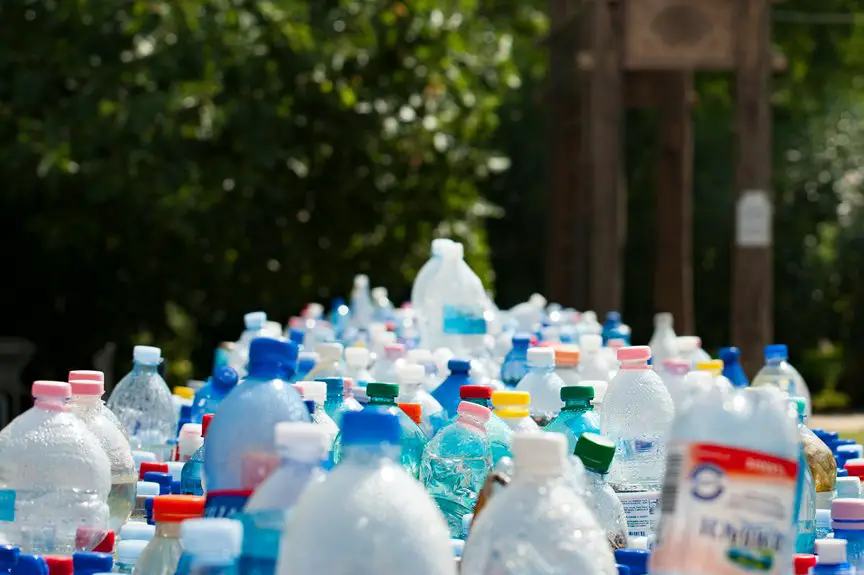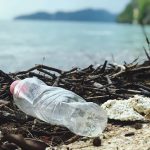When you consider RPET, it’s essential to understand where the plastic originates. Primarily, it comes from post-consumer PET products like bottles and containers, collected through recycling initiatives. While this approach aims to promote sustainability, it raises an important question: Could those resources be better utilized elsewhere? The implications of RPET production on the environment and economy warrant a closer look. What might be the trade-offs involved in this recycling process?
Table of Contents
Key Takeaways
- RPET is sourced from post-consumer PET products, primarily plastic bottles and containers collected through recycling programs.
- The recycling process involves sorting, cleaning, shredding, and depolymerization to convert PET into reusable monomers.
- Increased demand for RPET necessitates robust recycling infrastructure to prevent loss of valuable materials and environmental benefits.
- Concerns exist that using RPET may divert resources from more sustainable alternatives, prompting evaluations of its overall environmental impact.
- Use cases for RPET include packaging and textiles, but it is essential to assess effectiveness compared to other sustainable materials.
Understanding Rpet: Sources and Raw Materials
When you think about RPET, or recycled polyethylene terephthalate, it’s essential to understand where it comes from and the raw materials involved.
Primarily, RPET is sourced from post-consumer PET products, like plastic bottles and containers. These items are collected through recycling programs, which play a significant role in diverting waste from landfills.
Once collected, the PET is cleaned and processed to remove contaminants, ensuring a high-quality end product. This process not only conserves natural resources but also reduces the carbon footprint associated with producing new plastic.
The Production Process of Rpet
After collecting and processing post-consumer PET products, the production of RPET begins.
First, the PET is sorted and cleaned to remove contaminants. Next, it’s shredded into small flakes, making it easier to melt down.
These flakes undergo a process called depolymerization, where they’re heated and chemically treated to break them down into their original monomers. This step is essential for guaranteeing high-quality recycled material.
Once depolymerized, the monomers are re-polymerized to create new PET resin. This resin can then be molded into various products, from bottles to fibers.
Throughout this process, it’s critical to maintain strict quality control to guarantee the final RPET meets industry standards, making it suitable for various applications.
Impact of Rpet Production on Recycling Infrastructure
As you explore the production of RPET, you’ll see how it directly impacts recycling infrastructure.
Investing in the right technology can greatly enhance recycling efficiency.
Infrastructure Investment Necessity
While the demand for RPET plastic continues to rise, the need for robust recycling infrastructure becomes increasingly critical.
Without proper systems in place, the benefits of recycling can quickly diminish. You might feel a sense of urgency when considering:
- The environmental impact of plastic waste piling up in landfills.
- The lost potential of valuable materials that could be reused.
- The strain on local communities facing pollution and health risks.
- The missed opportunities for creating green jobs through effective recycling initiatives.
Investing in recycling infrastructure not only supports RPET production but also guarantees a sustainable future.
Technological Advancements Influence
Technological advancements play an essential role in shaping the future of RPET production and recycling infrastructure. As innovations emerge, they can enhance sorting and processing capabilities, making recycling more efficient and accessible. You might be surprised to see how these advancements impact various stakeholders, from consumers to manufacturers.
Here’s a look at some emotional aspects of RPET production:
| Aspect | Positive Impact | Negative Consequence |
|---|---|---|
| Community Awareness | Increased recycling rates | Over-reliance on RPET |
| Environmental Health | Reduced plastic waste | Potential pollution risks |
| Economic Growth | Job creation in recycling | Market volatility |
| Technological Access | Improved recycling tech | Digital divide |
| Consumer Choices | Eco-friendly products | Greenwashing concerns |
Recycling Efficiency Improvements
Advancements in recycling technology have greatly boosted the efficiency of RPET production, transforming the entire recycling infrastructure.
You might be surprised to learn how these improvements impact not only the environment but also the economy and community.
Here are some key benefits:
- Increased collection rates: More materials are captured for recycling, reducing waste.
- Lower energy consumption: Modern processes require less energy, making recycling more sustainable.
- Enhanced quality of recycled materials: Improved sorting and processing lead to higher-quality RPET.
- Job creation: A growing recycling industry means more local jobs and economic growth.
With these advancements, the recycling landscape is evolving, making RPET a more viable and responsible option for addressing plastic waste.
Environmental Considerations of Rpet
As you consider the environmental implications of RPET plastic, it’s crucial to recognize its role in reducing landfill waste and conserving resources.
By recycling plastic bottles into RPET, you help minimize the need for virgin materials, which often require significant energy and water to produce. This process not only cuts down on pollution associated with new plastic production but also lowers greenhouse gas emissions.
Additionally, using RPET supports a circular economy, where materials are reused rather than discarded.
However, it’s vital to be mindful of the energy used in the recycling process itself and make sure that it doesn’t overshadow these benefits. Balancing these factors can help you make informed choices about the environmental impact of RPET.
Economic Considerations of Rpet Production
As you explore RPET production, it’s essential to take into account the economic factors at play.
Market growth projections indicate a rising demand, but you’ll also need to contemplate the necessary infrastructure investments and how these affect cost competitiveness.
Understanding these elements will help you grasp the financial landscape of RPET production.
Market Growth Projections
The RPET market is projected to grow considerably in the coming years, driven by increasing environmental awareness and demand for sustainable materials. This growth reflects a shift in consumer behavior and corporate responsibility.
You’ll find that:
- More brands are committing to using recycled materials.
- Consumers are actively seeking eco-friendly products.
- Governments are implementing stricter regulations on plastic waste.
- Innovations in recycling technology are making RPET more accessible.
These factors combine to create an optimistic outlook for RPET production.
As the market expands, you’ll likely see more investment and interest, paving the way for a greener future. Embracing RPET not only benefits the environment but also meets the growing desire for sustainable solutions.
It’s a win-win for everyone involved.
Infrastructure Investment Needs
While many companies recognize the benefits of RPET production, significant infrastructure investments are essential to support its growth.
You need to evaluate that developing recycling facilities, upgrading existing systems, and expanding collection networks all require substantial financial backing. These investments guarantee that you can efficiently process the increasing volumes of plastic waste and convert it into quality RPET.
Furthermore, a robust infrastructure will help streamline logistics and reduce contamination in recycled materials. By prioritizing these investments, you not only enhance the sustainability of RPET but also create a more resilient supply chain.
Ultimately, investing in infrastructure is key to revealing the full potential of RPET and making it a viable alternative in the plastic market.
Cost Competitiveness Factors
Understanding the cost competitiveness of RPET production involves examining various economic factors that influence its viability in the market.
As you consider the impact of RPET, think about these pivotal aspects:
- The fluctuating prices of raw materials can make production unpredictable.
- Investments in recycling technology can lead to higher initial costs.
- Market demand for sustainable products may drive prices up, making RPET more attractive.
- Potential cost savings from reduced landfill fees can offset expenses.
These elements highlight how economic considerations shape the future of RPET.
By weighing these factors, you can better appreciate the balance between sustainability and cost efficiency in the production of recycled plastics.
The journey towards a greener future is complex, yet essential.
Potential Diversion From Better Uses
As industries increasingly turn to RPET plastic for its recycling benefits, it’s essential to assess whether this shift diverts resources from more effective uses. While RPET offers a sustainable alternative, it’s vital to contemplate if the materials used could serve better purposes, like reducing pollution or creating durable products.
| Use Case | RPET Potential | Alternative Uses |
|---|---|---|
| Packaging | High | Biodegradable options |
| Textiles | Moderate | Reusable fabrics |
| Construction | Low | Sustainable materials |
| Consumer Goods | Moderate | Upcycled materials |
Frequently Asked Questions
How Is Rpet Quality Measured and Ensured?
Measuring rPET quality’s like tuning a fine instrument; you check its clarity, strength, and consistency. You guarantee standards through rigorous testing, certifications, and transparent sourcing, so you can trust its performance in your projects.
What Are the Uses of Non-Recyclable PET Plastics?
Non-recyclable PET plastics find various uses, like packaging for food, medical supplies, and construction materials. You’ll often see them in single-use items, where durability and moisture resistance make them ideal for specific applications.
How Does Consumer Behavior Affect Rpet Production?
Consumer behavior directly impacts rPET production. When you prioritize recycled products, manufacturers respond by increasing rPET usage. Your choices drive demand, influencing companies to invest more in sustainable practices and reducing reliance on virgin plastics.
What Role Do Brands Play in Promoting Rpet Usage?
Brands drive RPet usage by innovating sustainable designs, educating consumers about recycling, and committing to eco-friendly practices. By prioritizing these efforts, you’ll feel empowered to support a circular economy and make informed purchasing decisions.
Are There Alternatives to Rpet for Sustainable Packaging?
Yes, there are alternatives to rPET for sustainable packaging. You can explore options like biodegradable materials, compostable plastics, or plant-based packaging. Each choice helps reduce environmental impact and supports a more sustainable future for packaging solutions.
- Does Chiffon Fabric Stink - July 15, 2025
- Does Chiffon Fabric Affect the Economy - July 15, 2025
- Does Cotton Fabric Have a Nap - July 15, 2025







